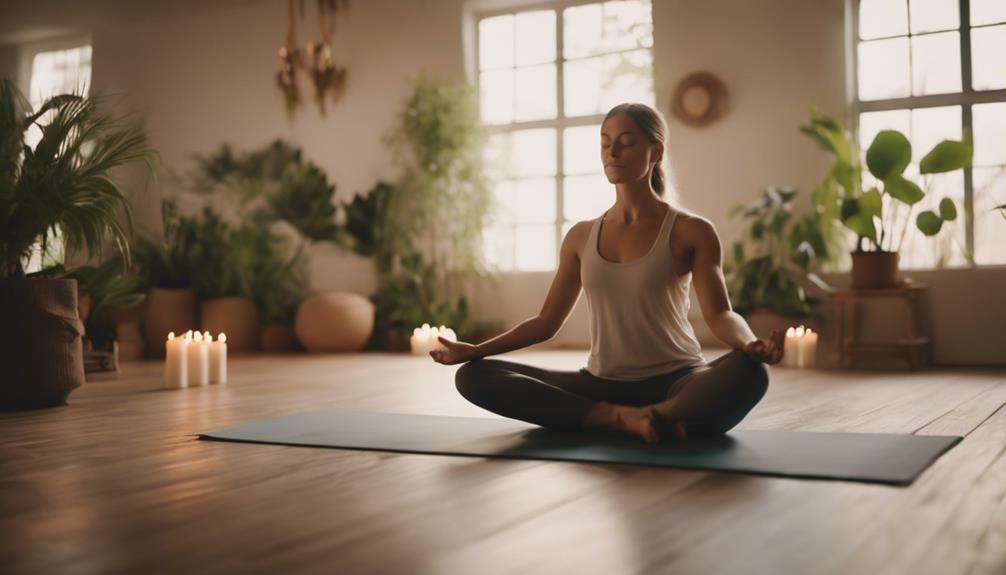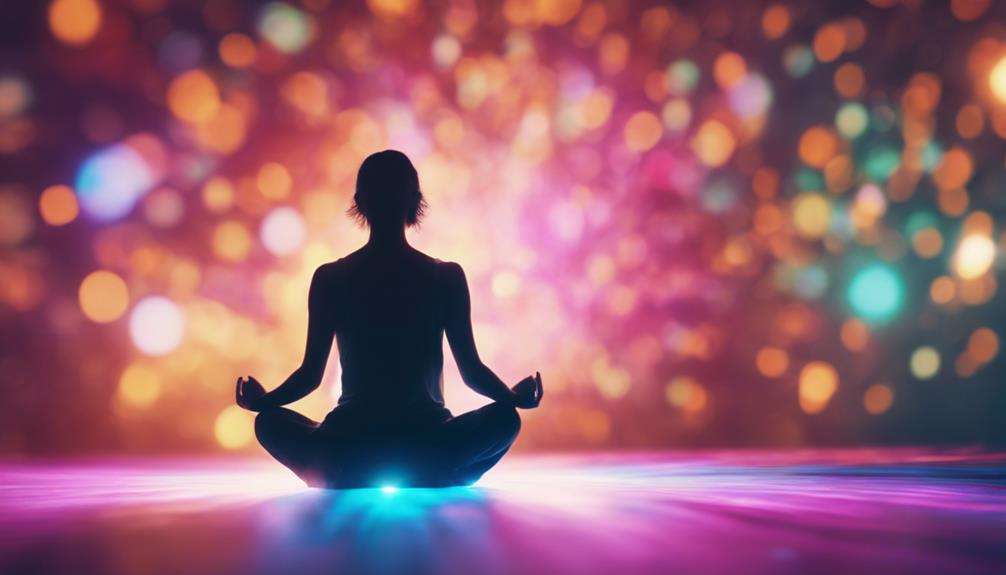When seeking mental calmness through meditation, exploring various techniques can offer you a range of options to find what resonates best with your practice.
From breath-focused methods like Focused Breathing to practices such as Guided Meditation and Visualization, each technique brings its unique approach to cultivating peace of mind.
Delving into the world of meditation techniques can be a transformative journey, providing you with tools to navigate the complexities of your thoughts and emotions.
Key Takeaways
- Mindfulness meditation cultivates present moment awareness and reduces anxiety.
- Deep breathing promotes relaxation, stress reduction, and improved focus.
- Loving-kindness practice enhances empathy, reduces depression symptoms, and fosters social connections.
- Visualization techniques use imagery to reduce anxiety and enhance mental clarity.
Mindfulness Meditation
Mindfulness meditation fosters mental calmness by encouraging you to focus on the present moment without judgment, aiding in reducing symptoms of anxiety and depression. When you engage in mindfulness meditation, you immerse yourself in the now, letting go of worries about the past or future. This practice cultivates self-awareness, allowing you to observe your thoughts and emotions without becoming entangled in them. By acknowledging your feelings without attaching judgment, you develop better emotional regulation skills. As you deepen your understanding of your inner workings through mindfulness, the grip of anxiety and depression can gradually loosen.
Through mindfulness meditation, you create a sanctuary within the present moment where stress fades away. This technique is versatile, fitting seamlessly into your daily routine. The beauty of mindfulness meditation lies in its simplicity; you can practice it anywhere, anytime. By dedicating even a few minutes each day to this practice, you can experience improved concentration, enhanced self-awareness, and a reduction in overall stress levels.
Deep Breathing
Engage in deep breathing, a fundamental meditation technique that promotes relaxation and reduces stress and anxiety. Deep breathing involves slow, intentional inhalation and exhalation, activating the body's relaxation response. By incorporating deep breathing into your daily routine, you can lower your heart rate, improve oxygen flow, and enhance mental clarity and focus. This technique is a powerful tool for managing stress and anxiety, as it helps regulate emotions and promote overall well-being.
Regular practice of deep breathing can lead to increased calmness and mental clarity. It's a simple yet effective way to combat the daily pressures that contribute to feelings of overwhelm. By focusing on your breath and engaging in deep, purposeful inhales and exhales, you can create a sense of peace and tranquility within yourself. Embrace deep breathing as a reliable method to cultivate mental calmness and combat the negative effects of stress and anxiety in your life.
Body Scan

To fully experience the benefits of Body Scan meditation, focus on progressively directing your attention to different body parts while promoting relaxation and releasing stress and tension. Body Scan meditation is a powerful mindfulness technique that can help you cultivate body awareness, relieve tension, and improve your overall well-being. By engaging in this practice, you can enhance the mind-body connection and achieve a state of deep relaxation. Here are some key points to keep in mind when practicing Body Scan:
- Enhances mindfulness: Body Scan meditation encourages you to stay present and focused on each part of your body, fostering a sense of mindfulness.
- Promotes relaxation: Through the systematic scanning of your body, you can release physical and mental tension, allowing for deep relaxation to occur.
- Releases stress: By acknowledging and letting go of stress held in different body areas, you can experience relief and a sense of calmness.
- Improves sleep quality: Body Scan meditation can help you become more attuned to bodily sensations, potentially aiding in improved sleep quality.
Loving-Kindness
As you transition from the focus on body awareness in Body Scan meditation, you can now explore the practice of Loving-Kindness, which cultivates compassion and empathy towards yourself and others. Loving-Kindness Meditation involves sending well-wishes and positive energy to enhance emotional well-being. By fostering forgiveness, gratitude, and positive emotions, this practice not only benefits your mental state but also enriches your daily life interactions. Research has shown that regular practice of Loving-Kindness Meditation can reduce symptoms of depression and anxiety, leading to improved social connections and overall mental health.
Engaging in Loving-Kindness Meditation allows you to develop a sense of interconnectedness with yourself and those around you. By generating feelings of love and compassion, you not only nurture your own well-being but also create a ripple effect of positivity in your relationships. This practice empowers you to approach challenges with empathy and understanding, fostering a more harmonious and compassionate outlook on life.
Visualization

When it comes to visualization in meditation, you can harness the power of imagery for relaxation and focus.
By practicing mindful vision techniques, you can enhance your mental clarity and peace.
Visualization is a powerful tool that can help you cultivate a sense of calmness and inner balance.
Imagery for Relaxation
Consider immersing yourself in the tranquil world of visualization meditation to unlock a pathway to deep relaxation and mental calmness. Visualization meditation, by conjuring mental images of peaceful scenes, is a potent tool for reducing anxiety, fostering inner peace, and enhancing stress management.
Here are some tips to make the most of imagery for relaxation:
- Create a Serene Sanctuary: Visualize a safe and peaceful place where you feel completely relaxed.
- Engage All Senses: Incorporate sounds, smells, and textures into your mental images for a more immersive experience.
- Practice Regularly: Dedicate time each day to delve into your visualization practice.
- Set Positive Intentions: Use this technique for setting goals and cultivating a positive mindset.
Mindful Vision Practice
Unlock a pathway to deep relaxation and mental calmness by practicing Mindful Vision Practice, also known as Visualization. This technique involves creating detailed mental images to promote relaxation and focus.
By visualizing peaceful scenes or positive outcomes, you can reduce anxiety, enhance creativity, and improve overall well-being. Studies have shown that Visualization can lower stress levels, boost mood, and increase feelings of well-being.
Incorporating this practice into your daily meditation routine can help you achieve your goals, manage pain, and enhance performance in various areas of your life. Embrace the power of mental images to cultivate a sense of tranquility and emotional balance within yourself.
Start your journey towards greater peace and focus through the practice of Mindful Vision.
Mantra Repetition
When it comes to finding mental calmness through meditation, mantra repetition can be a powerful tool. Focusing on a specific phrase or word can help quiet your mind and improve your ability to concentrate.
Silent Mind Focus
To enhance your mental calmness and focus, engage in the practice of Silent Mind Focus by silently repeating a mantra during meditation. This technique is highly effective in quieting mental chatter, allowing you to experience a profound sense of inner peace. By incorporating mantra repetition into your meditation routine, you can improve your concentration levels and enhance mindfulness in your daily life. Moreover, Silent Mind Focus serves as a powerful tool for reducing anxiety and stress, providing you with a pathway to emotional balance and mental clarity.
- Silent Mind Focus involves repeating a mantra silently to calm the mind and enhance focus.
- This technique helps in quieting mental chatter and promoting a state of inner peace.
- Mantra repetition during meditation can lead to improved concentration and mindfulness.
- Practicing Silent Mind Focus can aid in reducing anxiety and stress levels effectively.
Chanting for Peace
Enhance your inner peace and mental clarity through the calming practice of chanting mantras for peace during meditation. By focusing on a mantra, you can channel your attention away from distractions, allowing your mind to settle into a state of tranquility.
The repetitive nature of chanting helps in centering your thoughts, leading to improved concentration and a sense of peace within. Mantras like 'Om' or other specific phrases have a soothing effect on the nervous system, promoting relaxation and inner calmness.
Through regular practice of mantra meditation, you can cultivate a deeper connection to your inner self, fostering mental clarity and a profound sense of serenity. Embrace the power of chanting for peace to enrich your meditation practice and bring harmony to your mind.
Walking Meditation

Immerse yourself in the practice of walking meditation to cultivate mental calmness through a harmonious blend of mindfulness and movement. Walking meditation offers a unique opportunity to connect with your surroundings while focusing on the present moment.
- Mindful Movement: Engage in slow, deliberate steps, coordinating each movement with your breath to anchor yourself in the present.
- Nature Connection: Whether outdoors in a park or indoors in a quiet space, walking meditation allows you to appreciate the beauty of nature or create a peaceful environment for your practice.
- Inner Peace: Through the rhythmic motion of walking and attentive awareness, you can experience a sense of grounding, presence, and inner peace.
- Alternative to Sitting Meditation: For those who find it challenging to sit still, walking meditation provides a dynamic way to incorporate movement into mindfulness routines, fostering mental calmness in motion.
Progressive Muscle Relaxation
If you're seeking a way to release muscle tension, enhance body awareness, and reduce stress, Progressive Muscle Relaxation is a technique worth exploring.
By systematically tensing and relaxing different muscle groups, you can promote deep relaxation and alleviate physical tension.
This practice can help improve your sleep quality, decrease pain levels, and contribute to your overall well-being.
Muscle Tension Release
To begin releasing muscle tension and promoting relaxation, consider engaging in Progressive Muscle Relaxation, a technique involving the intentional tensing and relaxing of different muscle groups. This technique is effective in reducing stress, anxiety, and physical tension, ultimately improving mental health.
Here are some key points to understand about Progressive Muscle Relaxation:
- Technique: Progressive Muscle Relaxation focuses on systematically tensing and relaxing muscle groups.
- Stress and Anxiety: It helps in reducing stress and anxiety levels by promoting relaxation.
- Physical Tension: By releasing physical tension, this technique can alleviate muscle tightness and discomfort.
- Improve Mental Health: Regular practice of Progressive Muscle Relaxation can enhance relaxation skills, improve sleep quality, and boost overall mood and mental well-being.
Body Awareness Practice
Consider incorporating Progressive Muscle Relaxation into your daily routine to enhance your body awareness and promote relaxation.
This body awareness practice involves systematically tensing and then relaxing each muscle group in your body. By focusing on these muscle groups, you can release physical tension, improve your mind-body connection, and cultivate a sense of calmness.
Progressive Muscle Relaxation has been shown to reduce anxiety, enhance sleep quality, and alleviate symptoms of chronic pain. Integrating this meditation technique into your daily life can lead to improved stress management and overall well-being.
Start by finding a quiet space, close your eyes, and begin the practice by progressively tensing and relaxing different muscle groups, allowing yourself to experience the benefits of this relaxation method.
Stress Reduction Technique
Enhance your mental calmness and reduce stress levels by practicing the stress reduction technique known as Progressive Muscle Relaxation. This technique involves systematically tensing and relaxing muscle groups to alleviate muscle tension, anxiety, and stress, leading to improved overall well-being.
Here are some key points to consider when practicing Progressive Muscle Relaxation:
- Sequential Process: Tense specific muscle groups for a few seconds before releasing the tension.
- Stress Reduction: Effective in reducing stress levels and promoting relaxation.
- Therapeutic Benefits: Widely used in therapeutic settings to manage stress-related disorders.
- Improved Sleep: Enhances sleep quality and aids in achieving a state of mental and physical relaxation.
Yoga Nidra
Wondering how you can achieve deep relaxation and mental clarity through a form of guided meditation? Yoga Nidra might be just what you need. This practice involves lying down in a comfortable position, focusing on body awareness and breath, allowing you to enter a conscious sleep-like state. By engaging in Yoga Nidra, you can experience stress reduction, relaxation, and promote mental clarity. It's an effective technique for combating stress, anxiety, and insomnia, while also enhancing self-awareness, emotional healing, and inner peace.
Yoga Nidra isn't only about physical relaxation but also about calming the mind and finding balance within yourself. Through regular practice, you can improve your focus, creativity, and overall well-being. By tuning into your body and breath, you can release tension, cultivate mindfulness, and tap into a profound sense of tranquility. Give yourself the gift of Yoga Nidra to unwind, de-stress, and nourish your mind, body, and spirit.
Transcendental Meditation

Looking to achieve mental calmness and self-awareness through a structured meditation practice? Transcendental Meditation (TM) might be the perfect fit for you. Here are some key points to consider:
- Certified TM Teachers: TM is taught by certified instructors who guide practitioners on how to meditate properly.
- Specific Mantra: Participants in TM receive a specific mantra from their teachers, which they silently repeat during meditation to help focus and transcend other thoughts.
- Deep Relaxation: Engaging in TM for 15-20 minutes twice a day can lead to profound relaxation, allowing the mind and body to unwind.
- Stress Relief and Improved Well-being: Scientific studies have shown that regular practice of TM is associated with reduced stress levels and enhanced overall well-being and mental health.
Frequently Asked Questions
What Type of Meditation Calms the Mind?
To calm your mind, try mindfulness practice, breathing exercises, body scans, visualization techniques, loving-kindness meditation, mantra repetition, and guided imagery. These methods help reduce stress, enhance self-awareness, and promote emotional regulation for mental calmness.
Which Meditation Is Very Powerful?
Mantra meditation can be very powerful, promoting self-confidence and productivity. Breath awareness is key for grounding and calming the mind. Loving-kindness meditation cultivates compassion. Body scan helps release tension. Guided visualization enhances focus.
What Are the 7 Types of Meditation?
When exploring meditation, you'll encounter various types like mindfulness, loving-kindness, body scan, transcendental, Zen, mantra, and guided visualization. Each offers unique benefits from reducing stress to enhancing focus. Embrace these techniques for mental calmness.
What Are the 9 Popular Meditation?
To achieve mental calmness through meditation, try mindfulness practice, deep breathing, guided imagery, body scan, loving kindness, transcendental meditation, and mantra repetition. These techniques help in reducing stress, promoting relaxation, and enhancing emotional well-being.
Conclusion
Congratulations on exploring the top 10 meditation techniques for mental calmness! By incorporating these practices into your daily routine, you're taking significant steps towards achieving a peaceful and balanced state of mind.
The power of meditation to reduce stress, enhance relaxation, and improve focus can't be overstated.
Keep up the great work and continue to prioritize your mental well-being through these transformative techniques. Your journey to inner peace and mental clarity is well within reach!






